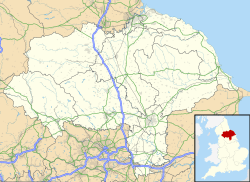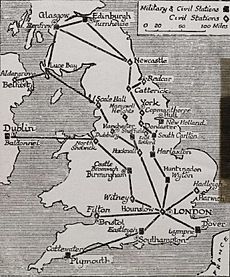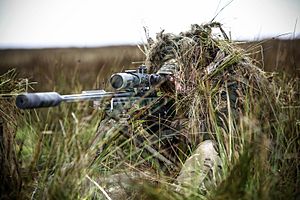RAF Catterick facts for kids
Quick facts for kids RAF Catterick
|
|||||||
|---|---|---|---|---|---|---|---|
| Catterick, North Yorkshire in England | |||||||
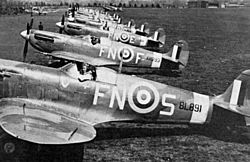
Spitfires of 331 Squadron at RAF Catterick in spring 1942
|
|||||||
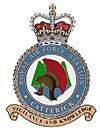
Vigilance and Knowledge
|
|||||||
|
Location in North Yorkshire
|
|||||||
| Coordinates | 54°21′55″N 001°37′11″W / 54.36528°N 1.61972°W | ||||||
| Type | Royal Air Force station Sector Station 1939- |
||||||
| Code | AK | ||||||
| Site information | |||||||
| Owner | Ministry of Defence | ||||||
| Operator | Royal Flying Corps (1914–1918) British Army (1927–1939) Royal Air Force (1918–1927 and 1939–1994) |
||||||
| Controlled by | RAF Fighter Command * No. 13 Group RAF * RAF Regiment |
||||||
| Condition | Transferred to the British Army and became Marne Barracks. | ||||||
| Site history | |||||||
| Built | 1914 | ||||||
| Built by | John Laing & Son Ltd | ||||||
| In use | 1914–1994 | ||||||
| Fate | Closed | ||||||
| Battles/wars | European theatre of World War II Cold War |
||||||
| Airfield information | |||||||
| Elevation | 53 metres (174 ft) AMSL | ||||||
|
|||||||
RAF Catterick was a very important airfield for the Royal Air Force (RAF) in England. It was located near Catterick, North Yorkshire, right next to the A6055 road.
Even though it started as a place for planes to fly, RAF Catterick later became the main training base for the RAF Regiment for almost 50 years. The station closed in 1994. After that, it was given to the British Army and is now known as Marne Barracks. Today, it is home to the 5th Regiment Royal Artillery and 32 Engineer Regiment.
Contents
History of RAF Catterick
Early Days as an Airfield (1914-1946)
Catterick airfield first opened in 1914. It was used by the Royal Flying Corps (RFC), which was the air force before the RAF. Its main jobs were to train pilots and help protect the North East of England.
In 1918, the RAF took over the airfield. It became home to No. 49 Training Depot Station, where many pilots learned to fly.
For a short time in 1927, the British Army managed the airfield. This was part of the RAF Army Cooperation Command, which provided air support to the army. But in 1939, the RAF took control again.
During the Second World War, Catterick also used a smaller, nearby airfield called RAF Scorton.
After the Second World War, Catterick's role changed. Its runway was not long enough for the new Jet Age aircraft. This was because the A1 and the River Swale were too close. So, from 1946 until 1994, Catterick became the main base for the RAF Regiment.
RAF Flying Squadrons at Catterick
Many different RAF squadrons were based at Catterick over the years. These squadrons flew various types of aircraft, including the Hawker Hurricane. They played a key role in defending the country and training new pilots.
Some of the squadrons that called Catterick home included:
- No. 17 Squadron RAF
- No. 26 Squadron RAF
- No. 41 Squadron RAF
- No. 54 Squadron RAF
- No. 64 Squadron RAF
- No. 118 Squadron RAF
- No. 130 Squadron RAF
- No. 222 Squadron RAF
- No. 306 Polish Fighter Squadron
- No. 331 Squadron RAF
- No. 401 Squadron RAF
- No. 609 Squadron RAF
Home of the RAF Regiment (1946-1994)
From 1946 to 1994, Catterick was the main training base for the RAF Regiment. This is a special part of the RAF that protects airfields and other RAF assets. During this time, many RAF Regiment squadrons were based here.
Catterick was also home to the RAF School of Fire Fighting until the 1990s. This school trained RAF firefighters. They had a special area where they would set old aircraft on fire to practice putting out blazes and rescuing people. For example, in 1983, two large Avro Vulcan bombers were used for these training exercises.
In the 1980s, Catterick had the largest collection of armoured vehicles in the UK for the British forces. These included FV101 Scorpion vehicles and FV103 Spartan armoured carriers. The base also trained soldiers on the Rapier air defence system. After the Falklands War, some captured Argentinian anti-aircraft cannons were even used here for training.
The RAF Regiment was very important to the local area. In 1971, they were given the "Freedom of Richmond, North Yorkshire". This was a special honour from the townspeople. Even though the Regiment is no longer at Catterick, they still celebrate this honour each year with a parade in Richmond.
Marne Barracks: A New Chapter
On June 30, 1994, RAF Catterick officially closed. The RAF Regiment training moved to RAF Honington. The site was then given to the British Army and renamed Marne Barracks. It is now part of the larger Catterick Garrison complex.
Marne Barracks has modern living areas for soldiers. It also has shops, a gym, and even a hairdresser. Some of the old RAF hangars have been changed into maintenance areas for the army's vehicles.
Motorsport at Catterick
For a few years, between 1958 and 1963, part of the airfield was used as a race track. It was known as Catterick Circuit and hosted various motorsport events.
See also
- List of former Royal Air Force stations


